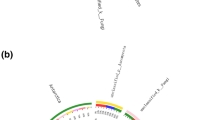Abstract
This survey is concerned only with filamentous fungi living in the soil layer. The observed diversity of soil fungi largely depends on the method used and the numbers of isolates obtained. Particle-plating usually yields higher numbers of taxa than dilution plating. The Centraalbureau voor Schimmelcultures (CBS) preserves a great diversity of soil fungi. The CBS database contained 2,210 species of soil fungi in 2001, an estimated 70% of the known species available in culture. Thus, the current estimate for described culturable soil fungi is approximately 3,150 species, many of which have a cosmopolitan distribution. Adding the ca. 150 spp. of nonculturable Glomerales results in 3,300 species of currently known soil fungi. Molecular studies in such groups as Fusarium, Trichoderma, Penicillium, and Aspergillus are finding a number of more narrowly distributed cryptic species. Thus the number of species of soil fungi is expected to be considerably higher than the 3300 species currently known.
Similar content being viewed by others
References
Anon. (2001) List of cultures: fungi (filamentous fungi and yeasts), bacteria, plasmids, phages, 35th edn. Centraalbureau voor Schimmelcultures, Fungal Biodiversity Center, Utrecht
Bettucci L, Roquebert M-F (1995) Microfungi from a tropical rain forest litter and soil. Nova Hedwigia 61:111–118
Bills GF, Christensen M, Powell MJ, Thorn G (2004) Saprobic soil fungi. In: Mueller GM, Bills GF, Foster MS (eds) Biodiversity of fungi: inventory and monitoring methods. Elsevier Academic Press, San Diego, CA, pp 271–302
Burgess LW, Summerell A, Backhouse D, Benyon F, Levic J (1996) Biodiversity and population studies in Fusarium. Sydowia 48:1–11
Domsch KH, Gams W, Anderson T-H (1980) Compendium of soil fungi. Academic Press, London. 2nd edition updated by W. Gams, 2006. Centraalbureau voor Schimmelcultures, Utrecht, in press
Frisvad JC, Filtenborg O, Wicklow DT (1987) Terverticillate penicillia isolated from underground seed caches and cheek pouches of banner-tailed kangaroo rats (Dipodomys spectabilis). Can J Bot 65:765–773
Gams W (1992) The analysis of communities of saprophytic microfungi with special reference to soil fungi. In: Winterhoff W (ed) Fungi in vegetation science. Kluwer, Dordrecht, pp 182–223
Hawksworth DL (1991) The fungal dimension of biodiversity: magnitude, significance and conservation. Mycol Res 95:641–655
Mouchacca J (1995) Thermophilic fungi in desert soils: a neglected extreme environment. In Allsopp D, Colwell RR, Hawksworth DL (eds) Microbial diversity and ecosystem function. CAB International, Wallingford, pp 265–288
Mouchacca J (2005) Mycobiota of the arid Middle East: check-list of novel fungal taxa introduced from 1940 to 2000 and major recent biodiversity titles. J Arid Environ 60:359–387
Nagai K, Sakai T, Rantiatmodjo RM, Suzuki K, Gams W, Okada G (1995) Studies on the distribution of alkalophilic and alikali-tolerant soil fungi I. Mycoscience 36:247–256
O’Donnell K, Cigelnik E, Nirenberg HI (1998) Molecular systematics and phylogeography of the Gibberella fujikuroi species complex of Fusarium. Mycologia 90:465–493
Pfenning L (1997) Soil and rhizosphere microfungi from Brazilian tropical forest ecosystems. In: Hyde KD (eds) Biodiversity of tropical microfungi. Hong Kong University Press, Hong Kong, pp 341–365
Rambelli A, Persiani AM, Maggi O, Onofri S, Riess S, Dowgiallo G, Zucconi L (1984) Comparative studies on microfungi in tropical ecosystems. Further mycological studies in South Western Ivory Coast forest. Report N. 2. Giornale Botanico Italiano 118:201–243
Rambelli A, Mulas B, Pasqualetti M (2004) Comparative studies on microfungi in tropical ecosystems in Ivory Coast forest litter: behaviour on idfferent substrata. Mycol Res 108:325–336
Redecker D, Hijri I, Wiemken A (2003) Molecular identification of arbuscular mycorrhizal fungi in roots: perspectives and problems. Folia Geobot 38:113–124
Samson RA, Frisvad JC (2004) Penicillium subgenus Penicillium: new taxonomic schemes, mycotoxins and other extrolites. Stud Mycol 49:1–260
Samuels GJ, Petrini O, Kuhls K, Lieckfeldt E, Kubicek CP (1998) The Hypocrea schweinitzii complex and Trichoderma sect. Longibrachiatum. Stud Mycol 41:1–54
Summerell BA, Rugg CA, Burgess LW (1995) Characterization of Fusarium babinda sp. nov. Mycol Res 99:1345-1348
Author information
Authors and Affiliations
Corresponding author
Rights and permissions
About this article
Cite this article
Gams, W. Biodiversity of soil-inhabiting fungi. Biodivers Conserv 16, 69–72 (2007). https://doi.org/10.1007/s10531-006-9121-y
Received:
Accepted:
Published:
Issue Date:
DOI: https://doi.org/10.1007/s10531-006-9121-y




